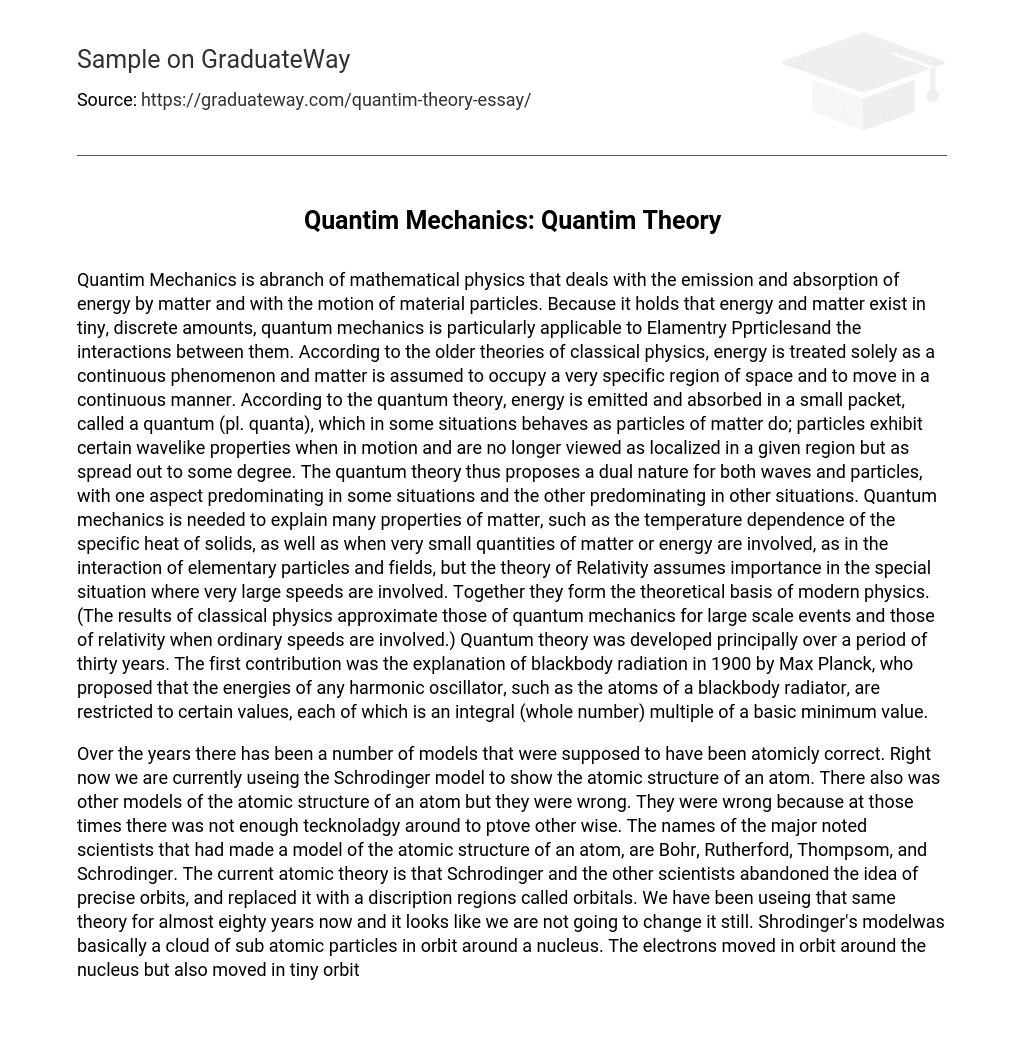Quantum Mechanics, a branch of mathematical physics, explores the emission and absorption of energy by matter, as well as the motion of material particles. Its focus on energy and matter existing in discrete amounts makes it particularly applicable to Elementary Particles and their interactions. In contrast, classical physics treats energy as a continuous phenomenon and assumes matter is localized in a specific region of space and moves continuously. However, according to the quantum theory, energy is emitted and absorbed in small packets called quanta, which can behave like particles. Under this theory, particles exhibit both wavelike and localized properties. This duality applies in different situations, with one aspect dominating over the other. Quantum mechanics is essential for explaining various properties of matter, including the temperature dependence of the specific heat of solids and interactions involving small quantities of matter or energy, such as those occurring between elementary particles and fields. However, the theory of Relativity becomes significant when dealing with high-speed scenarios. Together, these theories form the foundation of modern physics.Quantum theory, developed over thirty years, approximates classical physics for large scale events and relativity for ordinary speeds. In 1900, Max Planck made the first contribution by explaining blackbody radiation. He proposed that the energies of any harmonic oscillator, like atoms in a blackbody radiator, are limited to specific values, which are multiples of a minimum value.
Over the years, several atomic models have been proposed, each claiming to be accurate. Currently, the Schrodinger model is used to represent the atomic structure. Other models existed in the past but were proven incorrect due to limited technology. Notable scientists such as Bohr, Rutherford, Thompson, and Schrodinger contributed to various atomic structure models. The current atomic theory suggests that precise orbits have been abandoned in favor of describing regions known as orbitals. This theory has been utilized for nearly eighty years and is unlikely to be changed. Schrodinger’s model depicts a cloud of subatomic particles orbiting a nucleus. Electrons move within orbits around the nucleus but also occupy small orbitals. These orbitals revolve around potentially another subatomic particle while orbiting the nucleus containing protons, neutrons, and other subatomic particles.
Another scientist who developed an atomic structure model was Rutherford. In his model, the atom was held together by an electrical attraction between the nucleus and the electrons. The electrons revolved in distant orbits around the nucleus. This model proved successful in chemistry and everyday physics. Later studies focused on the electronic components of the atom, which became known as atomic physics, and on the nucleus itself, which became known as nuclear physics.
By subjecting hydrogen to electricity, the researcher examined its properties. The application of electricity would prompt an electron to become energized and move to higher energy levels. As the electron transitioned back to its original state, it emitted a photon. This emitted photon represented the energy associated with each specific energy level.
Among the influential scientists who made significant contributions to the scientific community, Rutherford stands out. In 1898, Rutherford became a physics professor at McGill University in Montreal. He proposed an atomic model that highlighted the role of electrical attraction between the nucleus and electrons in holding the atom together. According to his model, electrons moved in distant orbits around the nucleus. The success of this model in explaining various phenomena in chemistry and everyday physics became evident over time. Further research on the atom then branched into two fields: atomic physics focused on studying the electronic components of the atom, while nuclear physics delved into investigating the nucleus itself.
In his experiment, he bombarded a sheet of gold foil with alpha particles and made the discovery that the atom is not a solid mass, but instead consists entirely of empty space.
Thompson, another scientist, made a significant breakthrough in the current model of the atomic structure. In 1895, he discovered the electron by conducting an experiment with an apparatus that allowed him to observe the glow of negatively charged particles released when a gas is exposed to intense electrical forces – these particles are now known as electrons. Thompson’s experiments provided evidence that the atom is not an indivisible particle but is composed of different particles. In recognition of his discoveries, Thomson was awarded the Nobel Prize in 1906. His atomic model depicted the atom as a solid sphere with embedded electrons within the positive part of the atom. The positive part, which constitutes the majority of the atom’s mass and volume, was hypothesized to be fluid.
John Dalton, an English scientist, taught mathematics and physical sciences at New College, Manchester. He revived the atomic theory of matter and applied it to a table of atomic weights. Dalton also developed his law of partial pressures and studied color blindness, also known as Daltonism.
none





